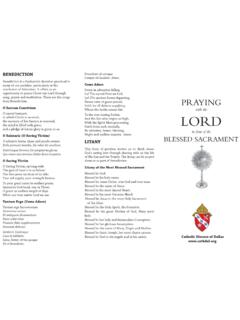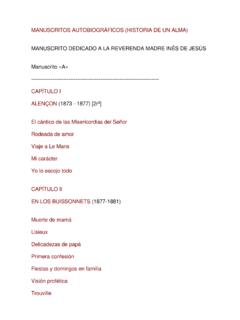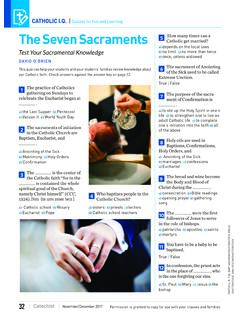Transcription of The Developmental Coordination Disorder Questionnaire …
1 TTHHEE DDEEVVEELLOOPPMMEENNTTAALL CCOOOORRDDIINNAATTIIOONN DDIISSOORRDDEERR QQUUEESSTTIIOONNNNAAIIRREE 22000077 ((DDCCDDQQ 0077)) AAddmmiinniissttrraattiioonn mmaannuuaall ffoorr tthhee DDCCDDQQ 0077 wwiitthh ppssyycchhoommeettrriicc pprrooppeerrttiieess Wilson, , OT(C) and Crawford, Calgary, Alberta, Canada BBBNNN WWWiiilllsssooonnn 222000000777 March 2012 We gratefully acknowledge the financial support of the Alberta Children s Hospital Foundation and the Alberta Center for Child, Family and Community Research Wilson, , Crawford, , Green, D., Roberts, G., Aylott, A., & Kaplan, B. (2009). Psychometric Properties of the Revised Developmental Coordination Disorder Questionnaire . Physical & Occupational Therapy in Pediatrics, 29(2):182-202. B. N. Wilson, 2007 Table of Contents Acknowledgments 3 Section I Introduction 4 Administration of the Developmental Coordination Disorder Questionnaire (DCDQ 07) 4 Scoring the Revised DCDQ 07 6 Interpretation of Scores for the DCDQ 07 6 Frequently Asked Questions 9 Scenarios demonstrating the use of the DCDQ 07 14 Section II Developmental Coordination Disorder (DCD) 17 Assessment of DCD and Comparison of the Performance of Different Measures 17 Development of the Original DCDQ 18 Why was the DCDQ developed?
2 18 Summary of Research on the Original DCDQ 18 Rationale for Further Validation and Revision 19 Revision of the DCDQ 21 Summary of Revision 21 Factor analysis 21 Strengths of the DCDQ 07 22 Comparison of the performance of the DCDQ to other measures of DCD 22 Summary of Psychometric Properties of the Revised DCDQ 07 23 Section III Summaries of research on the original DCDQ 25 Summaries of research on the DCDQ 07 31 Section IV Cross-cultural adaptation of the DCDQ and DCDQ 07 33 Process of cross-cultural adaptation 34 Summaries of cross-cultural adaptation 34 Other adaptations of the DCDQ and the DCDQ 07 38 References 39 B. N. Wilson, 2007 Acknowledgements The purpose of this report is to provide evidence on an instrument, the Developmental Coordination Disorder Questionnaire (DCDQ), used to identify children with Developmental Coordination Disorder (DCD).
3 With the improvements made to this instrument, more children who experience these motor challenges can receive increased support. The impetus for the revision of the DCDQ, and for this manual, is due to the continued collaboration and professional support provided to me over many years from many colleagues --most importantly, Nancy Pollock, Cheryl Missiuna and Dido Green. They have acted as advisors, giving freely of their time and sharing their valuable experience. I sincerely thank them for their ongoing support. I am also grateful for the opportunities to partner with Gwen Roberts and Loralie Clark over the years. The Behavioural Research Unit at Alberta Children s Hospital supported the development of the original DCDQ and of this revision, which has been very much appreciated. Occupational and physical therapists working at the Alberta Children s Hospital and in community programs for children in Calgary volunteered to act as members of a Clinical Advisory Committee.
4 This Committee met between 2002 and 2005 to support the revision of the DCDQ, and have recently begun to meet again to support this report and further adaptations of the DCDQ. Members of these two groups included Stacey Babcock, Kim Beckers, Melissa Brust, Anne Campbell, Loralie Clark, Gillian Hoyt-Hallett, Jenny Johnson, Gillian Macartney, Karen Mcintosh, Barb Mikkelsen, Teresa Nelles, Susan Robinson, Beth Richie, Gwen Roberts, Anne Robillard, Brigitte Roy, and Anita Wamsley. This clinical input into test development has been invaluable and is greatly appreciated. Many other colleagues have provided support and inspired debate that has lead to increased clarity on the issues surrounding the assessment of DCD: Bonnie Kaplan and Dianne Creighton in Calgary; Marina Schoemaker and Arend de Kloet in the Netherlands; and John Cairney in Canada.
5 International collaborators who have adapted the DCDQ for use in their settings have inspired me to be no less diligent in strengthening the Questionnaire , especially Livia de Castro Magalh es, Mei Tseng, Shula Parush and Marina Schoemaker. The development of the original DCDQ and this revision was funded by the Alberta Children s Hospital Foundation, Calgary, Alberta, which is gratefully acknowledged. The Alberta Center for Child, Family and Community Research supported the development of a web site and this manual. The Calgary Board of Education and the Calgary catholic Separate School Board generously supported the research. Mary Hodges, Alice Aylott, Laurie Kennedy, Maureen Mahon, Michelle Lorimer and Helen Soucie provided valuable technical and editorial support.
6 Finally and not least, thank you Susan -- for all your contributions to this and much of my work, and for adjusting to my fits and starts style of working. Brenda N. Wilson, March 2012 B. N. Wilson, 2007 SECTION I Introduction The original version of the Developmental Coordination Disorder Questionnaire (DCDQ) was first published in 1999 and reported in the American Journal of Occupational Therapy in 2000 (Wilson, Kaplan, Crawford, Campbell, & Dewey, 2000). After several years of widespread use and translation into several other languages, a second study to revise and re-validate the Questionnaire was undertaken in 2004. This resulted in the current version of the Questionnaire , which is known as the DCDQ 07 and is considered to be a more robust instrument (Wilson, Crawford, Green, Roberts, Aylott, & Kaplan, 2009).
7 Scientific information and evidence on the use of the Questionnaire refers to the DCDQ 07, although the Questionnaire that is given to parents is known as the Coordination Questionnaire . The following section will outline general information about administering the Questionnaire , followed by frequently asked questions (FAQ s). Studies supporting the recommendations here are referenced and found at the end of this section. Administration of the DCDQ 07 To avoid parents being concerned that a medical condition is being evaluated, the Questionnaire is labelled The Coordination Questionnaire . It is recommended that this two page Questionnaire be copied double sided, and that the parents receive only one sheet, without the score sheet. Using the Coordination Questionnaire with Families Before giving the Questionnaire to a parent, it is recommended that a contact name and phone number be written into the space on the first page so that parents can call if they have questions about the meaning of an item.
8 Should questions of this nature arise, this contact person should be knowledgeable about DCD, or know to whom to refer the question. The validity of the results will be increased if parents have the opportunity for clarification. Prior to Administration It is recommended that the two page Questionnaire be copied double sided. The Score Sheet on the fourth page should be kept separate from the Questionnaire itself. It is recommended that parents are not given the Score Sheet. The DCDQ 07 usually takes parents about 10-15 minutes to complete. As much as possible, arrange for the parent completing the Questionnaire to do so in a non-distracting environment. Time to Complete B. N. Wilson, 2007 This Questionnaire was developed for parents, as parents know their children the best and can reliably report Developmental problems.
9 Only the data from parent report was used to develop the scoring system; therefore, the DCDQ 07 is intended to be used with parents. Respondents However, clinicians and researchers are experimenting with having both parents, or one parent and the child s primary school teacher, complete it. Sometimes two or more respondents have completed the Questionnaire separately, but in other situations they have conversed while completing one form. Although the inter-rater reliability appears to be satisfactory, no conclusive studies have been done. When the perspective of two adults gives a more complete or more accurate evaluation of the child s motor performance, this practice is likely to increase the validity of the score. However, it must be remembered that the scores were developed solely on parent response, so if the respondents have divergent opinions on the child s performance, or if the two forms have very different scores, the parent s score should be the one reported.
10 The fact that others who know the child score the items differently can be noted but it would be inappropriate, for example, to use the score of a teacher or coach alone when interpreting the results of the DCDQ 07. During the development of the original DCDQ, parents were given the choice of completing a paper version of the Questionnaire on their own, or of completing it over the phone along with the interviewer while they read their paper copy. For the DCDQ 07 study, most parents completed a paper copy independently but a small proportion completed it with an occupational therapist. All of these methods of completion, independently, with a professional, or over the phone, are valid forms of administration. Written or Verbal Administration If English is the second language, or if the parent s reading ability is not clear, reading the questions to the parent and helping them respond is important for validity of the results.




